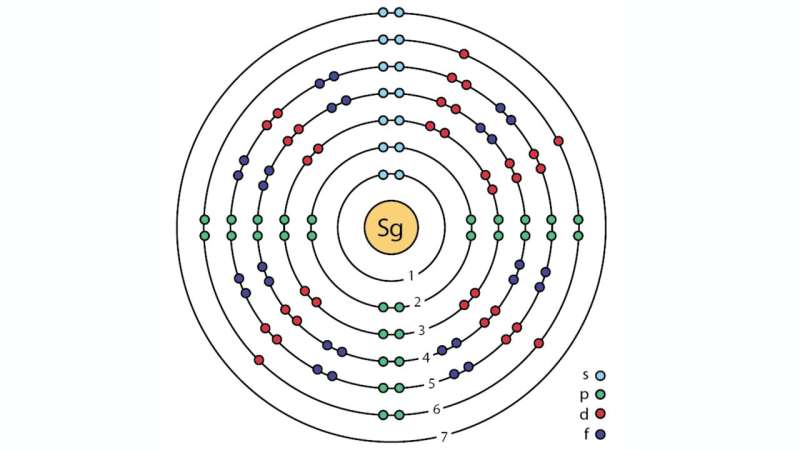New Superheavy Isotope Uncovers Intricate Link Between Quantum Effects and Fission

June 30, 2025 feature
by Tejasri Gururaj, Phys.org
contributing writer
edited by Sadie Harley, reviewed by Robert Egan
scientific editor
associate editor
This article has been reviewed according to Science X's editorial process and policies. Editors have highlighted the following attributes while ensuring the content's credibility:
fact-checked
peer-reviewed publication
trusted source
proofread
In a study published in Physical Review Letters, scientists at GSI Helmholtzzentrum für Schwerionenforschung have discovered a new superheavy isotope, 257Sg (seaborgium), whose properties are providing new insights into nuclear stability and fission in the heaviest elements.
Superheavy elements exist in a delicate balance between the attractive nuclear force that holds protons and neutrons together and the repulsive electromagnetic force that pushes positively charged protons apart.
Without quantum shell effects, analogous to electron shells in atoms, these massive nuclei would split apart in less than a trillionth of a second.
Phys.org spoke to co-authors Dr. Pavol Mosat and Dr. J. Khuyagbaatar from GSI Helmholtzzentrum für Schwerionenforschung, Germany, about their work.
The study reveals our incomplete understanding of how the most extreme atomic nuclei behave, with the findings suggesting that the quantum effects that keep superheavy nuclei from instantly disintegrating might operate differently than previously believed.
The international research team used GSI's gas-filled recoil separator TASCA to create 257Sg through fusion reactions between chromium-52 and lead-206 nuclei.
They found that the new isotope lives for 12.6 milliseconds, longer than its even-even neighbor 258Sg, and decays through both spontaneous fission and alpha-particle emission.
The alpha decay pathway proved particularly revealing. When 257Sg emits an alpha particle, it transforms into 253Rf (rutherfordium), which then undergoes fission after just 11 microseconds.
This observation supports recent findings that have questioned the traditional understanding of how angular momentum affects fission. While higher K quantum numbers were expected to provide stronger fission hindrance, emerging data suggests this relationship may be more complex than previously believed.
'We studied 257Sg and 253Rf isotopes and found that, in general, K-quantum numbers do indeed hinder fission,' said Mosat. 'However, the absolute value of hindrances is still unknown.'
Perhaps even more significant was the team's discovery of the first K-isomeric state in a seaborgium isotope. K-isomers are special nuclear configurations with high angular momentum that resist fission far more effectively than ordinary nuclear states.
In 259Sg, the researchers detected a conversion electron signal appearing 40 microseconds after nuclear formation, strong evidence for a K-isomeric state that could be stable against the fission hundreds of times longer than the ground state.
'K isomeric states have already been observed in superheavy nuclei such as 252–257Rf, and 270Ds,' noted Khuyagbaatar. 'We observed K-isomer exclusively in nuclei with 106 protons, i.e., in Sg isotopes for the first time.'
This finding fills a crucial gap in scientists' understanding of superheavy elements and could have profound implications for future element discovery efforts.
The discovery comes at a critical time in superheavy element research.
Scientists have long searched for the theoretical 'island of stability,' a region where certain superheavy nuclei might exist for extended periods due to favorable shell effects. However, the new findings suggest this landscape may be more complex than anticipated.
'It may happen that the superheavy nucleus, for instance, an isotope of a not-yet-discovered element, may live less than 1 μs [microsecond],' explained Khuyagbaatar.
'If so, then the discovery of element 120 will likely face separation and detection challenges. However, if a K-isomeric state exists in this nucleus, it could live longer, as we recently demonstrated with 252Rf.'
The researchers estimate that the still-undiscovered 256Sg could have a dramatically shorter half-life than theoretical predictions suggest, potentially dropping from the predicted 6 microseconds to just one nanosecond.
Such a significant deviation in stability would represent an important new insight in nuclear physics.
Discover the latest in science, tech, and space with over 100,000 subscribers who rely on Phys.org for daily insights. Sign up for our free newsletter and get updates on breakthroughs, innovations, and research that matter—daily or weekly.
The experimental achievement required overcoming significant technical challenges. Working with nuclei that exist for mere milliseconds demanded extraordinarily fast detection systems and precise timing.
'In the case of short-lived nuclei, it is very important to have a relatively short-length separator and, more crucially, to have fast digital electronics that can disentangle radioactive decay signals down to about 100 ns,' explained Khuyagbaatar.
The team developed specialized digital electronics at GSI that have proven crucial for multiple superheavy element discoveries.
The team's next goal is synthesizing 256Sg to test whether the predicted dramatic decrease in stability actually occurs.
'Indeed, we will try to explore further cases of long-lived K-isomeric states in superheavy nuclei,' said Mosat. 'Concerning the current topic, our nearest plan will be to try to synthesize the next unknown 256Sg.'
Written for you by our author Tejasri Gururaj, edited by Sadie Harley, and fact-checked and reviewed by Robert Egan —this article is the result of careful human work. We rely on readers like you to keep independent science journalism alive. If this reporting matters to you, please consider a donation (especially monthly). You'll get an ad-free account as a thank-you.
More information: P. Mosat et al, Probing the Shell Effects on Fission: The New Superheavy Nucleus 257Sg, Physical Review Letters (2025). DOI: 10.1103/s7hr-y7zq
Journal information: Physical Review Letters
© 2025 Science X Network




